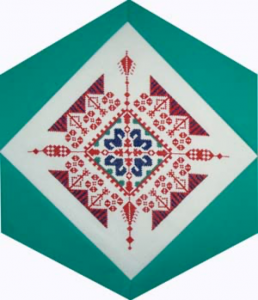Bahrain

The Block
Within the Bahraini culture, embroidery is highly valued for both home and clothing decoration. Customs, traditions and social environment directly influence women’s attire, and as a result there are dresses––in a wide variety of designs, colours and embroidery––for almost every occasion. This block, stitched by Heather McKellar, features a small sampling of the elaborate needlework used to embellish traditional Bahraini attire. The centre features a variation of the ‘moon with eight rays’ design, and through the incorporation of the ‘Ram’s Horn’ motif, reflects the influence of Turkomen embroidery. Slightly different versions of the cypress tree (symbols of death and rebirth) extend to each corner of the piece, while triangles, trees of life and moons with eight rays frame it. The central cross within each ‘moon with eight rays’ is a talismanic design known as ‘the wide open eye, and is meant to ward off evil.
Cultural Profile
Bahrain, in western Asia, is an independent nation connected to Saudi Arabia by a 25 kilometre causeway. It comprises an archipelago of 33 islands––the three largest of which are Bahrain Island, Al-Muharraq and Sitrah––on the western side of the Persian Gulf (also known as the Arabian Gulf). Bahrain’s name is derived from an Arabic word meaning ‘two seas’ and although there is some debate on which seas are being referred to, many believe them to be the sea around Bahrain and the abundant natural spring waters under the island itself. Much of the country is covered in desert however. In the midst of so much arid land flourishes the 400-year old “Tree of Life” (Sharajat-al-Hayat)––its water source unknown. Despite the desert, Bahrain––once called the “land of a million palm trees”––has long been known for the lush greenery of its date palm groves, leading some to believe the country was the original site of the ‘Garden of Eden.’ The local population is made up predominantly of native Bahrainis as well as various minority groups. ‘Expats’ account for half of the people living on the archipelago, attracted by the opportunities offered by the oil and gas and financial sectors. The official language is Arabic, although following years of British influence, English is widely spoken and understood, as is Farsi and Urdu.
Bahrain, known as the ‘Pearl of the Arabian Gulf,’ was once a chief centre of pearling. Fidjeri, the songs of the pearl divers, is a cultural creation associated with Bahrain. The archipelago was the first country in the Gulf in which oil was discovered (1902). Drilling and processing did not begin until the 1930s––the same time the international pearl market was collapsing––and oil revenues financed improved education and health care for Bahrainis. Despite the encroachment of modernization, the basic rhythms of life in many villages remain the same. Gahwa (coffee)––poured from a dallah (coffee-pot) into a finjan (small cup)––plays an important social and ceremonial role. Traditional crafts, such as carpet weaving, pottery making and the centuries-old art of dhow (boat) building are still practiced. Basket weaving using palm fronds remains an important craft and colourful fibers are used to produce baskets and dining mats.
People have been coming to Canada from Bahrain since 1946’s. Many come to study at Canadian universities. Though the overall number of Bahraini immigrants is small, like their pearls of old, the riches of their ancient culture are still treasured and preserved.
Sponsor: Martha Weber, in memoriam of her sister Ruth on the anniversary of her death
